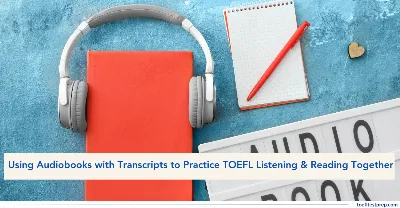Using Audiobooks with Transcripts to Practice TOEFL iBT® Listening & Reading Together

"Strengthen TOEFL Listening and Reading skills using audiobooks with transcripts. Boost comprehension, vocabulary, and fluency with this dual-skill method."
Key Highlights
TOEFL prep doesn’t have to mean long hours with textbooks and repetitive drills. What if you could improve your listening and reading skills while enjoying a good story or learning something new? Using audiobooks with transcripts is a fun and effective method that closely mirrors the kind of tasks you'll face on test day. It helps build comprehension, vocabulary, and focus while keeping your study routine fresh and enjoyable.
Let’s explore how this simple technique can make your preparation more engaging and rewarding.
Why Use Audiobooks with Transcripts for TOEFL Prep?
Using audiobooks with transcripts is a smart and enjoyable way to improve your TOEFL Listening and Reading skills. Here’s how this method can help:
-
You practise listening and reading together, just like in the actual TOEFL test.
-
You understand how native speakers build and connect ideas in English.
-
You get used to the tone, speed, and rhythm of natural spoken English.
-
You improve your vocabulary by hearing and seeing new words in context.
-
You read faster and with better focus as you follow along with the transcript.
-
You learn the correct pronunciation and sentence flow through regular listening.
-
You train your mind to stay focused for longer periods, which is helpful during the test.
|
Tackle the listening section with confidence! |
How to Choose the Right Audiobooks for TOEFL Practice
Not all audiobooks are useful for TOEFL preparation. You need content that sounds similar to what you’ll hear on test day—academic, well-structured, and clear. Below are the types of audiobooks to choose, their ideal length, and where to find them.
Recommended Genres:
-
Non-fiction (Science, History, Psychology, Economics)
These topics use academic language and explain real-world ideas clearly. They help you build vocabulary and understand complex sentence structures. -
Academic lectures or essay-style audiobooks
These mimic the kind of content used in TOEFL listening tasks. They focus on delivering facts, arguments, and explanations in a formal tone. -
Classic and modern literature with rich vocabulary
Books by authors like George Orwell or Jane Austen often include advanced vocabulary and varied sentence patterns useful for both reading and writing. -
Short story collections with well-structured narration
Stories that follow a clear beginning, middle, and end help you practise summarising ideas and following logical flow—skills needed in both TOEFL Reading and Listening.
What to Avoid:
-
Light fiction with slang-heavy dialogue
Stories that rely mostly on casual conversations may not be helpful, as TOEFL tasks require formal understanding and structured thinking. -
Overly long novels
These can be hard to follow and review, especially if you don’t have a lot of time. Stick to shorter content with clear ideas and chapters.
Ideal Audiobook Length:
-
Start with 10 to 20 minute segments
This keeps your study sessions focused and easier to manage. Shorter clips allow time for listening, reading the transcript, and reviewing new words.
Sources to Explore:
-
Audible – Paid platform with a wide range of academic and non-fiction titles.
-
LibriVox – Free public domain audiobooks, including classics.
-
Spotify – Many free audiobooks, especially short stories and essays.
-
YouTube – Channels offering free audiobooks with subtitles or transcripts.
-
Google Books – Some books offer both text and audio versions.
|
You might find this helpful: TOEFL Reading Tips: How to Read Complex & Long Sentences |
How to Use Audiobooks and Transcripts Together
Here are the steps to make the most of audiobooks and transcripts in your TOEFL prep:
Step 1: Listen Without Reading First
Play the selected clip without looking at the transcript. Try to understand the main idea, tone, and structure.
Step 2: Listen Again While Reading
This time, follow along with the transcript while listening. Focus on:
-
Matching spoken and written words
-
Identifying tone and emphasis
-
Noticing linking words and pauses
Step 3: Read Aloud
Read a few paragraphs aloud. This boosts fluency and helps with intonation and pronunciation.
Step 4: Shadow Short Segments
Repeat short sentences right after hearing them. This shadowing technique reinforces how native speakers express ideas.
Step 5: Vocabulary Notebook
Underline or highlight new vocabulary from the transcript and write example sentences. Look for synonyms and collocations.
|
Check out Common TOEFL Reading Section Difficulties |
Weekly TOEFL Practice Plan Using Audiobooks
| Day | Activity |
|---|---|
| Monday | Listen to a 10-min nonfiction audiobook. Summarise the main idea. |
| Tuesday | Read the transcript aloud. Note down 5 new academic words. |
| Wednesday | Shadow 5 sentences. Record and compare your speech. |
| Thursday | Listen without transcript. Then, answer 5 TOEFL-style comprehension Qs. |
| Friday | Combine listening + transcript. Focus on transitions and connectors. |
| Saturday | Practice writing a summary of the audiobook using academic vocabulary. |
| Sunday | Take a break or review difficult passages from the week. |
|
You might find this helpful : Boost Your TOEFL Listening Skills With These 7 Real-Life Resources |
Sample Practice: Audiobook Passage Breakdown
Here’s a sample breakdown to help you practise TOEFL Listening, Reading, and Speaking using an audiobook and its transcript. This method lets you notice tone, learn academic words, and respond to ideas clearly—just like in the real test.
Audiobook Excerpt (from a Science Essay):
“The ecosystem is a dynamic network where every element, from microorganisms to apex predators, plays a critical role. Disrupting even the smallest component can ripple through the entire system.”
Listening Focus:
Pay attention to how the speaker emphasises key phrases like “dynamic network” and “ripple through.” This helps you train your ear for main ideas and tone.
Reading Focus:
Understand and underline useful vocabulary: ecosystem, apex, ripple.
Notice the sentence structure—it connects ideas using cause and effect.
Speaking Practice:
Use the passage as a prompt:
“Describe an ecosystem you’ve learned about and explain how small changes can impact the whole system.”
This activity helps you link listening, reading, and speaking in a single practice session—just like TOEFL integrated tasks.
I hope this blog on using audiobooks with transcripts helped you discover a smart and enjoyable way to practice both TOEFL Listening and Reading. With consistent effort, this method can build your comprehension speed, pronunciation, and academic vocabulary—exactly what TOEFL requires. Add it to your routine and make learning more immersive and efficient.
Additional Resources:
- What to Do If You Can't Understand a TOEFL Reading Passage
- How the TOEFL Reading Section Evaluates Critical Thinking
- How to Score 30/30 on the TOEFL Listening?
- How to Keep Up with Fast Speakers in TOEFL Listening Tasks
- Daily TOEFL Listening Exercises for a 30-Day Study Plan
- Best Podcasts and Audio Resources for TOEFL® Listening Practice
- TOEFL Reading Section Myths and Misconceptions
Featured Articles

TOEFL Format Undergoing Significant Changes in January 2026
The TOEFL iBT format is changing in January 2026 with a smarter structure and easier scoring. Here’s everything you need to know to stay ahead.
August 06, 2025
Minimum TOEFL Score Requirement for South Korea Student Visa
Understand the TOEFL requirement for a South Korea student visa and English-taught programs, and prepare your application for success.
September 14, 2025
Minimum TOEFL Score for Study Visa in Poland
Understand TOEFL score requirements for securing a Poland student visa and joining top universities offering English-taught programs.
September 14, 2025
TOEFL Requirements for Animation & VFX Programs Abroad
Discover TOEFL score requirements for studying Animation and VFX abroad, and learn how to meet them for top creative universities.
September 14, 2025